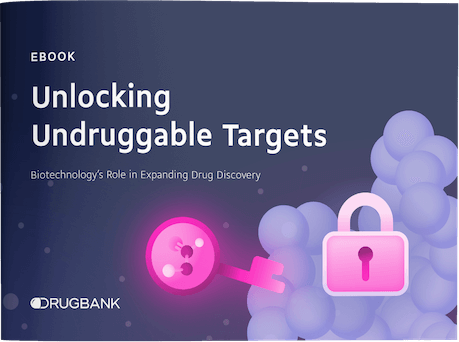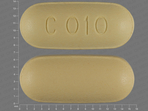Explore a selection of our essential drug information below, or:
Identification
- Summary
Methyltestosterone is a synthetic anabolic steroid used for the replacement therapy in conditions associated with testosterone deficiencies in males, such as hypogonadism, and treatment of advancing inoperable metastatic breast cancer in females.
- Brand Names
- Covaryx, Methitest
- Generic Name
- Methyltestosterone
- DrugBank Accession Number
- DB06710
- Background
A synthetic anabolic steroid used for treating men with testosterone deficiency or similar androgen replacement therapies. Also, has antineoplastic properties and so has been used secondarily in women with advanced breast cancer. Methyltestosterone is a schedule III drug in the US.
- Type
- Small Molecule
- Groups
- Approved
- Structure
- Weight
- Average: 302.451
Monoisotopic: 302.224580204 - Chemical Formula
- C20H30O2
- Synonyms
- 17-beta-Hydroxy-17-methylandrost-4-en-3-one
- 17-methyltestosterone
- 17alpha-Methyl-3-oxo-4-androsten-17beta-ol
- 17alpha-Methyltestosterone
- 17beta-Hydroxy-17-methylandrost-4-en-3-one
- 17α-methyl-Δ4-androsten-17β-ol-3-one
- 17α-methyltestosterone
- 4-Androstene-17alpha-methyl-17beta-ol-3-one
- Methyltestosterone
- Methyltestosteronum
- Metiltestosterona
- External IDs
- L 589.372
- NSC-139965
- RU 24400
Pharmacology
- Indication
Methyltestosterone is an anabolic steroid hormone used to treat men with a testosterone deficiency. It is also used in women to treat breast cancer, breast pain, swelling due to pregnancy, and with the addition of estrogen it can treat symptoms of menopause.
 Reduce drug development failure ratesBuild, train, & validate machine-learning modelswith evidence-based and structured datasets.Build, train, & validate predictive machine-learning models with structured datasets.
Reduce drug development failure ratesBuild, train, & validate machine-learning modelswith evidence-based and structured datasets.Build, train, & validate predictive machine-learning models with structured datasets.- Associated Conditions
Indication Type Indication Combined Product Details Approval Level Age Group Patient Characteristics Dose Form Management of Delayed puberty •••••••••••• Management of Hypogonadotropic hypogonadism •••••••••••• Treatment of Metastatic breast cancer •••••••••••• •••••••••••••• Treatment of Primary hypogonadism •••••••••••• Used in combination to treat Testosterone deficiency Combination Product in combination with: alpha-Tocopherol acetate (DB14003) •••••••••••• ••••••• ••••••• •••••• - Contraindications & Blackbox Warnings
 Prevent Adverse Drug Events TodayTap into our Clinical API for life-saving information on contraindications & blackbox warnings, population restrictions, harmful risks, & more.Avoid life-threatening adverse drug events with our Clinical API
Prevent Adverse Drug Events TodayTap into our Clinical API for life-saving information on contraindications & blackbox warnings, population restrictions, harmful risks, & more.Avoid life-threatening adverse drug events with our Clinical API- Pharmacodynamics
Testosterone is a steroid hormone from the androgen group. Testosterone is primarily secreted from the testes of males. In females, it is produced in the ovaries, adrenal glands and by conversion of adrostenedione in the periphery. It is the principal male sex hormone and an anabolic steroid. In both males and females, it plays key roles in health and well-being. Examples include enhanced libido, energy, immune function, and protection against osteoporosis. On average, the adult male body produces about twenty times the amount of testosterone than an adult female's body does.
- Mechanism of action
The effects of testosterone in humans and other vertebrates occur by way of two main mechanisms: by activation of the androgen receptor (directly or as DHT), and by conversion to estradiol and activation of certain estrogen receptors. Free testosterone (T) is transported into the cytoplasm of target tissue cells, where it can bind to the androgen receptor, or can be reduced to 5α-dihydrotestosterone (DHT) by the cytoplasmic enzyme 5α-reductase. DHT binds to the same androgen receptor even more strongly than T, so that its androgenic potency is about 2.5 times that of T. The T-receptor or DHT-receptor complex undergoes a structural change that allows it to move into the cell nucleus and bind directly to specific nucleotide sequences of the chromosomal DNA. The areas of binding are called hormone response elements (HREs), and influence transcriptional activity of certain genes, producing the androgen effects.
Target Actions Organism AAndrogen receptor agonistHumans UEstrogen receptor Not Available Humans - Absorption
The methyl group aids to increase oral bioavailability.
- Volume of distribution
Not Available
- Protein binding
40% of testosterone in plasma is bound to sex hormone-binding globulin and 2% remains unbound and the rest is bound to albumin and other proteins.
- Metabolism
Hepatic. Testosterone is metabolized to 17-keto steroids through two different pathways. The major active metabolites are estradiol and dihydrotestosterone (DHT).
- Route of elimination
90% urine / 10% feces
- Half-life
6-8 hours
- Clearance
Not Available
- Adverse Effects
 Improve decision support & research outcomesWith structured adverse effects data, including: blackbox warnings, adverse reactions, warning & precautions, & incidence rates. View sample adverse effects data in our new Data Library!Improve decision support & research outcomes with our structured adverse effects data.
Improve decision support & research outcomesWith structured adverse effects data, including: blackbox warnings, adverse reactions, warning & precautions, & incidence rates. View sample adverse effects data in our new Data Library!Improve decision support & research outcomes with our structured adverse effects data.- Toxicity
Side effects include amnesia, anxiety, discolored hair, dizziness, dry skin, hirsutism, hostility, impaired urination, paresthesia, penis disorder, peripheral edema, sweating, and vasodilation.
- Pathways
- Not Available
- Pharmacogenomic Effects/ADRs
- Not Available
Interactions
- Drug Interactions
- This information should not be interpreted without the help of a healthcare provider. If you believe you are experiencing an interaction, contact a healthcare provider immediately. The absence of an interaction does not necessarily mean no interactions exist.
Drug Interaction Integrate drug-drug
interactions in your softwareAbacavir Abacavir may decrease the excretion rate of Methyltestosterone which could result in a higher serum level. Abametapir The serum concentration of Methyltestosterone can be increased when it is combined with Abametapir. Abatacept The metabolism of Methyltestosterone can be increased when combined with Abatacept. Acarbose Methyltestosterone may increase the hypoglycemic activities of Acarbose. Aceclofenac Aceclofenac may decrease the excretion rate of Methyltestosterone which could result in a higher serum level. - Food Interactions
- No interactions found.
Products
 Drug product information from 10+ global regionsOur datasets provide approved product information including:dosage, form, labeller, route of administration, and marketing period.Access drug product information from over 10 global regions.
Drug product information from 10+ global regionsOur datasets provide approved product information including:dosage, form, labeller, route of administration, and marketing period.Access drug product information from over 10 global regions.- Product Images
- International/Other Brands
- Testred / Virilon
- Generic Prescription Products
Name Dosage Strength Route Labeller Marketing Start Marketing End Region Image Android Capsule 10 mg/1 Oral Valeant Pharmaceuticals North America 1973-12-03 2018-04-30 US Methitest Tablet 10 mg/1 Oral Amneal Pharmaceuticals of New York Llc 1974-10-17 Not applicable US MethylTESTOSTERone Capsule 10 mg/1 Oral Amneal Pharmaceuticals of New York Llc 2015-09-21 Not applicable US Methyltestosterone Capsule 10 mg/1 Oral Novitium Pharma Llc 2022-02-18 Not applicable US Testred C-III Capsule 10 mg/1 Oral Valeant Pharmaceuticals North America 1973-12-03 2018-04-30 US - Mixture Products
Name Ingredients Dosage Route Labeller Marketing Start Marketing End Region Image ยาผสมฮอร์โมนชาย ที.พี Methyltestosterone (10 MG) + Vitamin E (10 MG) Tablet, sugar coated Oral บริษัท ที.พี.ดรัก แลบบอราทอรี่ส์ (1969) จำกัด 2008-10-27 Not applicable Thailand เทสโทฮอฟ Methyltestosterone (5 MG) + Vitamin E (3 MG) Tablet, coated Oral บริษัท โรงงานเภสัชอุตสาหกรรม เจเอสพี (ประเทศไทย) จำกัด (มหาชน) 2017-08-09 2020-09-29 Thailand - Unapproved/Other Products
Name Ingredients Dosage Route Labeller Marketing Start Marketing End Region Image Covaryx Methyltestosterone (2.5 mg/1) + Esterified estrogens (1.25 mg/1) Tablet, coated Oral Centrix Pharmaceutical 2007-04-01 Not applicable US 
Covaryx Hs Methyltestosterone (1.25 mg/1) + Esterified estrogens (0.625 mg/1) Tablet, coated Oral Centrix Pharmaceutical 2007-04-01 Not applicable US Eemt Methyltestosterone (2.5 mg/1) + Esterified estrogens (1.25 mg/1) Tablet, coated Oral Creekwood Pharmaceuticals LLC 2011-09-01 Not applicable US Eemt D.S. Methyltestosterone (1.25 mg/1) + Estrone sodium sulfate (0.625 mg/1) Tablet, coated Oral Breckenridge Pharmaceutical, Inc. 2003-11-01 2012-01-31 US Eemt H.S. Methyltestosterone (1.25 mg/1) + Esterified estrogens (0.625 mg/1) Tablet, coated Oral Physicians Total Care, Inc. 2006-06-27 2013-01-15 US
Categories
- ATC Codes
- G03BA02 — Methyltestosterone
- G03BA — 3-oxoandrosten (4) derivatives
- G03B — ANDROGENS
- G03 — SEX HORMONES AND MODULATORS OF THE GENITAL SYSTEM
- G — GENITO URINARY SYSTEM AND SEX HORMONES
- G03EA — Androgens and estrogens
- G03E — ANDROGENS AND FEMALE SEX HORMONES IN COMBINATION
- G03 — SEX HORMONES AND MODULATORS OF THE GENITAL SYSTEM
- G — GENITO URINARY SYSTEM AND SEX HORMONES
- Drug Categories
- 3-Oxoandrosten (4) Derivatives
- Anabolic Agents
- Androgens
- Androgens and Estrogens
- Androstanes
- Androstenes
- Androstenols
- Antineoplastic Agents
- Antineoplastic Agents, Hormonal
- Cytochrome P-450 CYP2B6 Substrates
- Cytochrome P-450 CYP3A Substrates
- Cytochrome P-450 CYP3A4 Substrates
- Cytochrome P-450 Substrates
- Drugs that are Mainly Renally Excreted
- Fused-Ring Compounds
- Genito Urinary System and Sex Hormones
- Hormones
- Hormones, Hormone Substitutes, and Hormone Antagonists
- OAT3/SLC22A8 Inducers
- Sex Hormones and Modulators of the Genital System
- Steroids
- Testosterone Congeners
- Thyroxine-binding globulin inhibitors
- Chemical TaxonomyProvided by Classyfire
- Description
- This compound belongs to the class of organic compounds known as androgens and derivatives. These are 3-hydroxylated C19 steroid hormones. They are known to favor the development of masculine characteristics. They also show profound effects on scalp and body hair in humans.
- Kingdom
- Organic compounds
- Super Class
- Lipids and lipid-like molecules
- Class
- Steroids and steroid derivatives
- Sub Class
- Androstane steroids
- Direct Parent
- Androgens and derivatives
- Alternative Parents
- 3-oxo delta-4-steroids / 17-hydroxysteroids / Delta-4-steroids / Cyclohexenones / Tertiary alcohols / Cyclic alcohols and derivatives / Organic oxides / Hydrocarbon derivatives
- Substituents
- 17-hydroxysteroid / 3-oxo-delta-4-steroid / 3-oxosteroid / Alcohol / Aliphatic homopolycyclic compound / Androgen-skeleton / Carbonyl group / Cyclic alcohol / Cyclic ketone / Cyclohexenone
- Molecular Framework
- Aliphatic homopolycyclic compounds
- External Descriptors
- enone, 3-oxo Delta(4)-steroid, 17beta-hydroxy steroid (CHEBI:27436) / C19 steroids (androgens) and derivatives (C07198) / C19 steroids (androgens) and derivatives (LMST02020029)
- Affected organisms
- Not Available
Chemical Identifiers
- UNII
- V9EFU16ZIF
- CAS number
- 58-18-4
- InChI Key
- GCKMFJBGXUYNAG-HLXURNFRSA-N
- InChI
- InChI=1S/C20H30O2/c1-18-9-6-14(21)12-13(18)4-5-15-16(18)7-10-19(2)17(15)8-11-20(19,3)22/h12,15-17,22H,4-11H2,1-3H3/t15-,16+,17+,18+,19+,20+/m1/s1
- IUPAC Name
- (1S,3aS,3bR,9aR,9bS,11aS)-1-hydroxy-1,9a,11a-trimethyl-1H,2H,3H,3aH,3bH,4H,5H,7H,8H,9H,9aH,9bH,10H,11H,11aH-cyclopenta[a]phenanthren-7-one
- SMILES
- [H][C@@]12CC[C@](C)(O)[C@@]1(C)CC[C@@]1([H])[C@@]2([H])CCC2=CC(=O)CC[C@]12C
References
- General References
- Not Available
- External Links
- Human Metabolome Database
- HMDB0015655
- KEGG Drug
- D00408
- KEGG Compound
- C07198
- PubChem Compound
- 6010
- PubChem Substance
- 99443262
- ChemSpider
- 5788
- BindingDB
- 50410531
- 6904
- ChEBI
- 27436
- ChEMBL
- CHEMBL1395
- ZINC
- ZINC000003814422
- PharmGKB
- PA165958383
- Wikipedia
- Methyltestosterone
Clinical Trials
- Clinical Trials
Clinical Trial & Rare Diseases Add-on Data Package
Explore 4,000+ rare diseases, orphan drugs & condition pairs, clinical trial why stopped data, & more. Preview package Phase Status Purpose Conditions Count Start Date Why Stopped 100+ additional columns Unlock 175K+ rows when you subscribe.View sample data2 Completed Treatment Hot Flushes, Menopause, Postmenopause 1 somestatus stop reason just information to hide 2 Completed Treatment Menopause 1 somestatus stop reason just information to hide 2 Recruiting Treatment Castration-Resistant Prostate Carcinoma / Metastatic Prostate Adenocarcinoma / Stage IVB Prostate Cancer AJCC v8 1 somestatus stop reason just information to hide 2 Terminated Treatment Menopause 2 somestatus stop reason just information to hide 1 Recruiting Supportive Care Hypogonadisms / Malignant Urinary System Neoplasm / Urinary System Disorder / Urinary System Neoplasm 1 somestatus stop reason just information to hide
Pharmacoeconomics
- Manufacturers
- Not Available
- Packagers
- Not Available
- Dosage Forms
Form Route Strength Tablet Oral 25 mg Tablet, coated Oral Tablet Oral Tablet, film coated Oral Tablet Oral 0.005 g Tablet Oral 10 mg / tab Tablet Oral 25 mg / tab Tablet Oral 10 mg/1 Capsule Oral 10 mg/1 Tablet, sugar coated Oral Capsule Oral 10 mg Tablet, coated Oral 10 mg - Prices
- Not Available
- Patents
- Not Available
Properties
- State
- Solid
- Experimental Properties
Property Value Source melting point (°C) 163 °C PhysProp water solubility 33.9 mg/L (at 25 °C) YALKOWSKY,SH & HE,Y (2003) logP 3.36 HANSCH,C ET AL. (1995) - Predicted Properties
Property Value Source Water Solubility 0.0139 mg/mL ALOGPS logP 3.61 ALOGPS logP 3.65 Chemaxon logS -4.3 ALOGPS pKa (Strongest Acidic) 18.52 Chemaxon pKa (Strongest Basic) -0.53 Chemaxon Physiological Charge 0 Chemaxon Hydrogen Acceptor Count 2 Chemaxon Hydrogen Donor Count 1 Chemaxon Polar Surface Area 37.3 Å2 Chemaxon Rotatable Bond Count 0 Chemaxon Refractivity 89.07 m3·mol-1 Chemaxon Polarizability 35.85 Å3 Chemaxon Number of Rings 4 Chemaxon Bioavailability 1 Chemaxon Rule of Five Yes Chemaxon Ghose Filter Yes Chemaxon Veber's Rule Yes Chemaxon MDDR-like Rule No Chemaxon - Predicted ADMET Features
Property Value Probability Human Intestinal Absorption + 1.0 Blood Brain Barrier + 0.9774 Caco-2 permeable + 0.8737 P-glycoprotein substrate Substrate 0.6431 P-glycoprotein inhibitor I Inhibitor 0.5981 P-glycoprotein inhibitor II Non-inhibitor 0.732 Renal organic cation transporter Non-inhibitor 0.757 CYP450 2C9 substrate Non-substrate 0.8075 CYP450 2D6 substrate Non-substrate 0.8604 CYP450 3A4 substrate Substrate 0.7916 CYP450 1A2 substrate Non-inhibitor 0.8619 CYP450 2C9 inhibitor Non-inhibitor 0.8844 CYP450 2D6 inhibitor Non-inhibitor 0.951 CYP450 2C19 inhibitor Non-inhibitor 0.6629 CYP450 3A4 inhibitor Non-inhibitor 0.8713 CYP450 inhibitory promiscuity Low CYP Inhibitory Promiscuity 0.8711 Ames test Non AMES toxic 0.9429 Carcinogenicity Non-carcinogens 0.9361 Biodegradation Not ready biodegradable 0.9494 Rat acute toxicity 2.0516 LD50, mol/kg Not applicable hERG inhibition (predictor I) Weak inhibitor 0.886 hERG inhibition (predictor II) Non-inhibitor 0.7219
Spectra
- Mass Spec (NIST)
- Not Available
- Spectra
- Chromatographic Properties
Collision Cross Sections (CCS)
Adduct CCS Value (Å2) Source type Source [M-H]- 181.2661164 predictedDarkChem Lite v0.1.0 [M-H]- 181.4418164 predictedDarkChem Lite v0.1.0 [M-H]- 180.8835164 predictedDarkChem Lite v0.1.0 [M-H]- 181.5307164 predictedDarkChem Lite v0.1.0 [M-H]- 171.98305 predictedDeepCCS 1.0 (2019) [M+H]+ 182.1172164 predictedDarkChem Lite v0.1.0 [M+H]+ 181.3277164 predictedDarkChem Lite v0.1.0 [M+H]+ 182.3375164 predictedDarkChem Lite v0.1.0 [M+H]+ 181.9768164 predictedDarkChem Lite v0.1.0 [M+H]+ 174.11662 predictedDeepCCS 1.0 (2019) [M+Na]+ 181.4550164 predictedDarkChem Lite v0.1.0 [M+Na]+ 182.0242164 predictedDarkChem Lite v0.1.0 [M+Na]+ 181.6795164 predictedDarkChem Lite v0.1.0 [M+Na]+ 181.4019164 predictedDarkChem Lite v0.1.0 [M+Na]+ 180.09163 predictedDeepCCS 1.0 (2019)
Targets

- Kind
- Protein
- Organism
- Humans
- Pharmacological action
- Yes
- Actions
- Agonist
- General Function
- Steroid hormone receptors are ligand-activated transcription factors that regulate eukaryotic gene expression and affect cellular proliferation and differentiation in target tissues (PubMed:19022849). Transcription factor activity is modulated by bound coactivator and corepressor proteins like ZBTB7A that recruits NCOR1 and NCOR2 to the androgen response elements/ARE on target genes, negatively regulating androgen receptor signaling and androgen-induced cell proliferation (PubMed:20812024). Transcription activation is also down-regulated by NR0B2. Activated, but not phosphorylated, by HIPK3 and ZIPK/DAPK3
- Specific Function
- androgen binding
- Gene Name
- AR
- Uniprot ID
- P10275
- Uniprot Name
- Androgen receptor
- Molecular Weight
- 99187.115 Da
References
- Small EJ, Ryan CJ: The case for secondary hormonal therapies in the chemotherapy age. J Urol. 2006 Dec;176(6 Pt 2):S66-71. [Article]
- Omwancha J, Brown TR: Selective androgen receptor modulators: in pursuit of tissue-selective androgens. Curr Opin Investig Drugs. 2006 Oct;7(10):873-81. [Article]
- Petraki CD, Sfikas CP: Histopathological changes induced by therapies in the benign prostate and prostate adenocarcinoma. Histol Histopathol. 2007 Jan;22(1):107-18. [Article]
- Maudsley S, Davidson L, Pawson AJ, Freestone SH, Lopez de Maturana R, Thomson AA, Millar RP: Gonadotropin-releasing hormone functionally antagonizes testosterone activation of the human androgen receptor in prostate cells through focal adhesion complexes involving Hic-5. Neuroendocrinology. 2006;84(5):285-300. Epub 2007 Jan 4. [Article]
- Lapauw B, Goemaere S, Crabbe P, Kaufman JM, Ruige JB: Is the effect of testosterone on body composition modulated by the androgen receptor gene CAG repeat polymorphism in elderly men? Eur J Endocrinol. 2007 Mar;156(3):395-401. [Article]
- Chen X, Ji ZL, Chen YZ: TTD: Therapeutic Target Database. Nucleic Acids Res. 2002 Jan 1;30(1):412-5. [Article]
- Kind
- Protein
- Organism
- Humans
- Pharmacological action
- Unknown
- Curator comments
- Interacting drug is a metabolite: Methyltestosterone is aromatized to methylestradiol which binds to estrogen receptors
- General Function
- Nuclear hormone receptor. The steroid hormones and their receptors are involved in the regulation of eukaryotic gene expression and affect cellular proliferation and differentiation in target tissues. Ligand-dependent nuclear transactivation involves either direct homodimer binding to a palindromic estrogen response element (ERE) sequence or association with other DNA-binding transcription factors, such as AP-1/c-Jun, c-Fos, ATF-2, Sp1 and Sp3, to mediate ERE-independent signaling. Ligand binding induces a conformational change allowing subsequent or combinatorial association with multiprotein coactivator complexes through LXXLL motifs of their respective components. Mutual transrepression occurs between the estrogen receptor (ER) and NF-kappa-B in a cell-type specific manner. Decreases NF-kappa-B DNA-binding activity and inhibits NF-kappa-B-mediated transcription from the IL6 promoter and displace RELA/p65 and associated coregulators from the promoter. Recruited to the NF-kappa-B response element of the CCL2 and IL8 promoters and can displace CREBBP. Present with NF-kappa-B components RELA/p65 and NFKB1/p50 on ERE sequences. Can also act synergistically with NF-kappa-B to activate transcription involving respective recruitment adjacent response elements; the function involves CREBBP. Can activate the transcriptional activity of TFF1. Also mediates membrane-initiated estrogen signaling involving various kinase cascades. Essential for MTA1-mediated transcriptional regulation of BRCA1 and BCAS3 (PubMed:17922032). Maintains neuronal survival in response to ischemic reperfusion injury when in the presence of circulating estradiol (17-beta-estradiol/E2) (By similarity)
- Specific Function
- 14-3-3 protein binding
- Gene Name
- ESR1
- Uniprot ID
- P03372
- Uniprot Name
- Estrogen receptor
- Molecular Weight
- 66215.45 Da
References
- Huang R, Sakamuru S, Martin MT, Reif DM, Judson RS, Houck KA, Casey W, Hsieh JH, Shockley KR, Ceger P, Fostel J, Witt KL, Tong W, Rotroff DM, Zhao T, Shinn P, Simeonov A, Dix DJ, Austin CP, Kavlock RJ, Tice RR, Xia M: Profiling of the Tox21 10K compound library for agonists and antagonists of the estrogen receptor alpha signaling pathway. Sci Rep. 2014 Jul 11;4:5664. doi: 10.1038/srep05664. [Article]
Enzymes
- Kind
- Protein
- Organism
- Humans
- Pharmacological action
- Unknown
- Actions
- Substrate
- General Function
- A cytochrome P450 monooxygenase involved in the metabolism of endocannabinoids and steroids (PubMed:12865317, PubMed:21289075). Mechanistically, uses molecular oxygen inserting one oxygen atom into a substrate, and reducing the second into a water molecule, with two electrons provided by NADPH via cytochrome P450 reductase (NADPH--hemoprotein reductase). Catalyzes the epoxidation of double bonds of arachidonoylethanolamide (anandamide) to 8,9-, 11,12-, and 14,15-epoxyeicosatrienoic acid ethanolamides (EpETrE-EAs), potentially modulating endocannabinoid system signaling (PubMed:21289075). Hydroxylates steroid hormones, including testosterone at C-16 and estrogens at C-2 (PubMed:12865317, PubMed:21289075). Plays a role in the oxidative metabolism of xenobiotics, including plant lipids and drugs (PubMed:11695850, PubMed:22909231). Acts as a 1,4-cineole 2-exo-monooxygenase (PubMed:11695850)
- Specific Function
- anandamide 11,12 epoxidase activity
- Gene Name
- CYP2B6
- Uniprot ID
- P20813
- Uniprot Name
- Cytochrome P450 2B6
- Molecular Weight
- 56277.81 Da
References
- Rendic S: Summary of information on human CYP enzymes: human P450 metabolism data. Drug Metab Rev. 2002 Feb-May;34(1-2):83-448. [Article]
- Kind
- Protein
- Organism
- Humans
- Pharmacological action
- Unknown
- Actions
- Substrate
- General Function
- A cytochrome P450 monooxygenase involved in the metabolism of sterols, steroid hormones, retinoids and fatty acids (PubMed:10681376, PubMed:11093772, PubMed:11555828, PubMed:12865317, PubMed:14559847, PubMed:15373842, PubMed:15764715, PubMed:19965576, PubMed:20702771, PubMed:21490593, PubMed:21576599). Mechanistically, uses molecular oxygen inserting one oxygen atom into a substrate, and reducing the second into a water molecule, with two electrons provided by NADPH via cytochrome P450 reductase (NADPH--hemoprotein reductase). Catalyzes the hydroxylation of carbon-hydrogen bonds (PubMed:12865317, PubMed:14559847, PubMed:15373842, PubMed:15764715, PubMed:21490593, PubMed:21576599, PubMed:2732228). Exhibits high catalytic activity for the formation of hydroxyestrogens from estrone (E1) and 17beta-estradiol (E2), namely 2-hydroxy E1 and E2, as well as D-ring hydroxylated E1 and E2 at the C-16 position (PubMed:11555828, PubMed:12865317, PubMed:14559847). Plays a role in the metabolism of androgens, particularly in oxidative deactivation of testosterone (PubMed:15373842, PubMed:15764715, PubMed:22773874, PubMed:2732228). Metabolizes testosterone to less biologically active 2beta- and 6beta-hydroxytestosterones (PubMed:15373842, PubMed:15764715, PubMed:2732228). Contributes to the formation of hydroxycholesterols (oxysterols), particularly A-ring hydroxylated cholesterol at the C-4beta position, and side chain hydroxylated cholesterol at the C-25 position, likely contributing to cholesterol degradation and bile acid biosynthesis (PubMed:21576599). Catalyzes bisallylic hydroxylation of polyunsaturated fatty acids (PUFA) (PubMed:9435160). Catalyzes the epoxidation of double bonds of PUFA with a preference for the last double bond (PubMed:19965576). Metabolizes endocannabinoid arachidonoylethanolamide (anandamide) to 8,9-, 11,12-, and 14,15-epoxyeicosatrienoic acid ethanolamides (EpETrE-EAs), potentially modulating endocannabinoid system signaling (PubMed:20702771). Plays a role in the metabolism of retinoids. Displays high catalytic activity for oxidation of all-trans-retinol to all-trans-retinal, a rate-limiting step for the biosynthesis of all-trans-retinoic acid (atRA) (PubMed:10681376). Further metabolizes atRA toward 4-hydroxyretinoate and may play a role in hepatic atRA clearance (PubMed:11093772). Responsible for oxidative metabolism of xenobiotics. Acts as a 2-exo-monooxygenase for plant lipid 1,8-cineole (eucalyptol) (PubMed:11159812). Metabolizes the majority of the administered drugs. Catalyzes sulfoxidation of the anthelmintics albendazole and fenbendazole (PubMed:10759686). Hydroxylates antimalarial drug quinine (PubMed:8968357). Acts as a 1,4-cineole 2-exo-monooxygenase (PubMed:11695850). Also involved in vitamin D catabolism and calcium homeostasis. Catalyzes the inactivation of the active hormone calcitriol (1-alpha,25-dihydroxyvitamin D(3)) (PubMed:29461981)
- Specific Function
- 1,8-cineole 2-exo-monooxygenase activity
- Gene Name
- CYP3A4
- Uniprot ID
- P08684
- Uniprot Name
- Cytochrome P450 3A4
- Molecular Weight
- 57342.67 Da
References
- Rendic S, Nolteernsting E, Schanzer W: Metabolism of anabolic steroids by recombinant human cytochrome P450 enzymes. Gas chromatographic-mass spectrometric determination of metabolites. J Chromatogr B Biomed Sci Appl. 1999 Nov 26;735(1):73-83. [Article]
- Kind
- Protein
- Organism
- Humans
- Pharmacological action
- Unknown
- Actions
- SubstrateInducer
- General Function
- A cytochrome P450 monooxygenase that catalyzes the conversion of C19 androgens, androst-4-ene-3,17-dione (androstenedione) and testosterone to the C18 estrogens, estrone and estradiol, respectively (PubMed:27702664, PubMed:2848247). Catalyzes three successive oxidations of C19 androgens: two conventional oxidations at C19 yielding 19-hydroxy and 19-oxo/19-aldehyde derivatives, followed by a third oxidative aromatization step that involves C1-beta hydrogen abstraction combined with cleavage of the C10-C19 bond to yield a phenolic A ring and formic acid (PubMed:20385561). Alternatively, the third oxidative reaction yields a 19-norsteroid and formic acid. Converts dihydrotestosterone to delta1,10-dehydro 19-nordihydrotestosterone and may play a role in homeostasis of this potent androgen (PubMed:22773874). Also displays 2-hydroxylase activity toward estrone (PubMed:22773874). Mechanistically, uses molecular oxygen inserting one oxygen atom into a substrate, and reducing the second into a water molecule, with two electrons provided by NADPH via cytochrome P450 reductase (CPR; NADPH-ferrihemoprotein reductase) (PubMed:20385561, PubMed:22773874)
- Specific Function
- aromatase activity
- Gene Name
- CYP19A1
- Uniprot ID
- P11511
- Uniprot Name
- Aromatase
- Molecular Weight
- 57882.48 Da
References
- Tsai CL, Wang LH, Fang LS: Estradiol and para-chlorophenylalanine downregulate the expression of brain aromatase and estrogen receptor-alpha mRNA during the critical period of feminization in tilapia (Oreochromis mossambicus). Neuroendocrinology. 2001 Nov;74(5):325-34. doi: 10.1159/000054699. [Article]
Carriers
- Kind
- Protein
- Organism
- Humans
- Pharmacological action
- Unknown
- General Function
- Binds water, Ca(2+), Na(+), K(+), fatty acids, hormones, bilirubin and drugs (Probable). Its main function is the regulation of the colloidal osmotic pressure of blood (Probable). Major zinc transporter in plasma, typically binds about 80% of all plasma zinc (PubMed:19021548). Major calcium and magnesium transporter in plasma, binds approximately 45% of circulating calcium and magnesium in plasma (By similarity). Potentially has more than two calcium-binding sites and might additionally bind calcium in a non-specific manner (By similarity). The shared binding site between zinc and calcium at residue Asp-273 suggests a crosstalk between zinc and calcium transport in the blood (By similarity). The rank order of affinity is zinc > calcium > magnesium (By similarity). Binds to the bacterial siderophore enterobactin and inhibits enterobactin-mediated iron uptake of E.coli from ferric transferrin, and may thereby limit the utilization of iron and growth of enteric bacteria such as E.coli (PubMed:6234017). Does not prevent iron uptake by the bacterial siderophore aerobactin (PubMed:6234017)
- Specific Function
- antioxidant activity
- Gene Name
- ALB
- Uniprot ID
- P02768
- Uniprot Name
- Albumin
- Molecular Weight
- 69365.94 Da
References
- Pardridge WM: Serum bioavailability of sex steroid hormones. Clin Endocrinol Metab. 1986 May;15(2):259-78. [Article]
- Kind
- Protein
- Organism
- Humans
- Pharmacological action
- Unknown
- General Function
- Functions as an androgen transport protein, but may also be involved in receptor mediated processes. Each dimer binds one molecule of steroid. Specific for 5-alpha-dihydrotestosterone, testosterone, and 17-beta-estradiol. Regulates the plasma metabolic clearance rate of steroid hormones by controlling their plasma concentration
- Specific Function
- androgen binding
- Gene Name
- SHBG
- Uniprot ID
- P04278
- Uniprot Name
- Sex hormone-binding globulin
- Molecular Weight
- 43778.755 Da
References
- Pardridge WM: Serum bioavailability of sex steroid hormones. Clin Endocrinol Metab. 1986 May;15(2):259-78. [Article]
Transporters
- Kind
- Protein
- Organism
- Humans
- Pharmacological action
- Unknown
- Actions
- InhibitorInducer
- General Function
- Na(+)-independent transporter that mediates the cellular uptake of a broad range of organic anions such as the endogenous bile salts cholate and deoxycholate, either in their unconjugated or conjugated forms (taurocholate and glycocholate), at the plasmam membrane (PubMed:19129463, PubMed:7557095). Responsible for intestinal absorption of bile acids (By similarity). Transports dehydroepiandrosterone 3-sulfate (DHEAS), a major circulating steroid secreted by the adrenal cortex, as well as estrone 3-sulfate and 17beta-estradiol 17-O-(beta-D-glucuronate) (PubMed:11159893, PubMed:12568656, PubMed:19129463, PubMed:23918469, PubMed:25560245, PubMed:9539145). Mediates apical uptake of all-trans-retinol (atROL) across human retinal pigment epithelium, which is essential to maintaining the integrity of the visual cycle and thus vision (PubMed:25560245). Involved in the uptake of clinically used drugs (PubMed:17301733, PubMed:20686826, PubMed:27777271). Capable of thyroid hormone transport (both T3 or 3,3',5'-triiodo-L-thyronine, and T4 or L-tyroxine) (PubMed:19129463, PubMed:20358049). Also transports prostaglandin E2 (PubMed:19129463). Plays roles in blood-brain and -cerebrospinal fluid barrier transport of organic anions and signal mediators, and in hormone uptake by neural cells (By similarity). May also play a role in the reuptake of neuropeptides such as substance P/TAC1 and vasoactive intestinal peptide/VIP released from retinal neurons (PubMed:25132355). May play an important role in plasma and tissue distribution of the structurally diverse chemotherapeutic drugs methotrexate and paclitaxel (PubMed:23243220). Shows a pH-sensitive substrate specificity which may be ascribed to the protonation state of the binding site and leads to a stimulation of substrate transport in an acidic microenvironment (PubMed:19129463). Hydrogencarbonate/HCO3(-) acts as the probable counteranion that exchanges for organic anions (PubMed:19129463). May contribute to regulate the transport of organic compounds in testis across the blood-testis-barrier (Probable)
- Specific Function
- bile acid transmembrane transporter activity
- Gene Name
- SLCO1A2
- Uniprot ID
- P46721
- Uniprot Name
- Solute carrier organic anion transporter family member 1A2
- Molecular Weight
- 74144.105 Da
References
- Lu R, Kanai N, Bao Y, Wolkoff AW, Schuster VL: Regulation of renal oatp mRNA expression by testosterone. Am J Physiol. 1996 Feb;270(2 Pt 2):F332-7. [Article]
- Kanai N, Lu R, Bao Y, Wolkoff AW, Vore M, Schuster VL: Estradiol 17 beta-D-glucuronide is a high-affinity substrate for oatp organic anion transporter. Am J Physiol. 1996 Feb;270(2 Pt 2):F326-31. [Article]
- Bossuyt X, Muller M, Hagenbuch B, Meier PJ: Polyspecific drug and steroid clearance by an organic anion transporter of mammalian liver. J Pharmacol Exp Ther. 1996 Mar;276(3):891-6. [Article]
- Kind
- Protein
- Organism
- Humans
- Pharmacological action
- Unknown
- Actions
- Inducer
- General Function
- Functions as an organic anion/dicarboxylate exchanger that couples organic anion uptake indirectly to the sodium gradient (PubMed:14586168, PubMed:15644426, PubMed:15846473, PubMed:16455804, PubMed:31553721). Transports organic anions such as estrone 3-sulfate (E1S) and urate in exchange for dicarboxylates such as glutarate or ketoglutarate (2-oxoglutarate) (PubMed:14586168, PubMed:15846473, PubMed:15864504, PubMed:22108572, PubMed:23832370). Plays an important role in the excretion of endogenous and exogenous organic anions, especially from the kidney and the brain (PubMed:11306713, PubMed:14586168, PubMed:15846473). E1S transport is pH- and chloride-dependent and may also involve E1S/cGMP exchange (PubMed:26377792). Responsible for the transport of prostaglandin E2 (PGE2) and prostaglandin F2(alpha) (PGF2(alpha)) in the basolateral side of the renal tubule (PubMed:11907186). Involved in the transport of neuroactive tryptophan metabolites kynurenate and xanthurenate (PubMed:22108572, PubMed:23832370). Functions as a biopterin transporters involved in the uptake and the secretion of coenzymes tetrahydrobiopterin (BH4), dihydrobiopterin (BH2) and sepiapterin to urine, thereby determining baseline levels of blood biopterins (PubMed:28534121). May be involved in the basolateral transport of steviol, a metabolite of the popular sugar substitute stevioside (PubMed:15644426). May participate in the detoxification/ renal excretion of drugs and xenobiotics, such as the histamine H(2)-receptor antagonists fexofenadine and cimetidine, the antibiotic benzylpenicillin (PCG), the anionic herbicide 2,4-dichloro-phenoxyacetate (2,4-D), the diagnostic agent p-aminohippurate (PAH), the antiviral acyclovir (ACV), and the mycotoxin ochratoxin (OTA), by transporting these exogenous organic anions across the cell membrane in exchange for dicarboxylates such as 2-oxoglutarate (PubMed:11669456, PubMed:15846473, PubMed:16455804). Contributes to the renal uptake of potent uremic toxins (indoxyl sulfate (IS), indole acetate (IA), hippurate/N-benzoylglycine (HA) and 3-carboxy-4-methyl-5-propyl-2-furanpropionate (CMPF)), pravastatin, PCG, E1S and dehydroepiandrosterone sulfate (DHEAS), and is partly involved in the renal uptake of temocaprilat (an angiotensin-converting enzyme (ACE) inhibitor) (PubMed:14675047). May contribute to the release of cortisol in the adrenals (PubMed:15864504). Involved in one of the detoxification systems on the choroid plexus (CP), removes substrates such as E1S or taurocholate (TC), PCG, 2,4-D and PAH, from the cerebrospinal fluid (CSF) to the blood for eventual excretion in urine and bile (By similarity). Also contributes to the uptake of several other organic compounds such as the prostanoids prostaglandin E(2) and prostaglandin F(2-alpha), L-carnitine, and the therapeutic drugs allopurinol, 6-mercaptopurine (6-MP) and 5-fluorouracil (5-FU) (By similarity). Mediates the transport of PAH, PCG, and the statins pravastatin and pitavastatin, from the cerebrum into the blood circulation across the blood-brain barrier (BBB). In summary, plays a role in the efflux of drugs and xenobiotics, helping reduce their undesired toxicological effects on the body (By similarity)
- Specific Function
- organic anion transmembrane transporter activity
- Gene Name
- SLC22A8
- Uniprot ID
- Q8TCC7
- Uniprot Name
- Organic anion transporter 3
- Molecular Weight
- 59855.585 Da
References
- Kobayashi Y, Hirokawa N, Ohshiro N, Sekine T, Sasaki T, Tokuyama S, Endou H, Yamamoto T: Differential gene expression of organic anion transporters in male and female rats. Biochem Biophys Res Commun. 2002 Jan 11;290(1):482-7. [Article]
Drug created at May 16, 2010 15:41 / Updated at February 21, 2021 18:52







